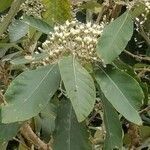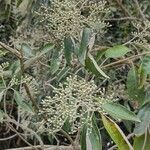Trees, to 20 m, stems and branches with stellate hairs, nodes swollen and inhabited by ants. Leaves alternate, ovate-elliptic, occasionally ovate, entire, acute or acute-mucronate, the bases obtuse or oblique, to 18 cm long and 8 cm wide, sparsely to densely covered with stellate hairs, especially on the undersurface; petioles to ca 3.5 cm long. Inflorescences irregular cymes, spreading and loose, or sometimes compacted, the primary panicles to 18-20 cm long. Flowers perfect, + sessile or with pedicels to ca 1 mm long; calyx tubular, ca 4-5 mm long, densely soft-pubescent, ca 10-ribbed and with 5 small teeth; corolla-tube cylindrical, ca 3 mm long, lobes 5, spreading, each ca 5-6 mm long, white to cream, somewhat hirsute at the throat, + persistent; stamens 5 (rarely more), borne at the corolla throat, the filaments ca 5-6 mm long at maturity, each with a hooked fimbriolate base, the anthers ca 1.5-1.8 mm long; ovary cylindrical, ca 1 mm long, ribbed or wrinkled, the style elongate, 3-4 mm long, the stigmas 4, as a result of 2 divisions, each less than 1 mm long. Fruit cylindrical, not drupaceous, the pericarp fibrous and chartaceous, ca 5-6 mm long.
More
Tree up to 20 m high, with grey, fissured bark. All herbaceous parts densely covered by very short, stellate hairs, especially the inflorescence. Leaves: petiole 1-3 cm long; blade broadly elliptic, 10-55 by 5-25(-30) cm, base obliquely truncate, subacute, apex subacute to acuminate, coriaceous, margin entire, upper surface glabrous, with slightly impressed nerves, lower surface stellate-pubescent with prominent nerves. Inflorescence terminal, laxly branched, with numerous, crowded flowers. Calyx subglobose, greyish pubescent, with 10 prominent ribs, 6-7(-14) mm long, truncate with indistinct teeth. Corolla tube longer than calyx, lobes oblong, rounded, 5-10 by c. 3 mm. Fruit 5 mm long, c. 3 mm in diam., deciduous together with calyx and corolla.
A tree. It grows 12 m high. The trunk is smooth and light coloured. There or four branches develop from a swelling on the stem. The leaf stalks are 1-3 cm long. The leaf blades are oblong and 10-20 cm long by 3-8 cm wide. The flowers are in a loosely branched arrangement. This is 10-30 cm across. The fruit is about 5 mm long.
Dry and wet forest, often of secondary growth, and commonly on moist limestone soils. A pioneer plant, it is found in a wide range of habitats from sea level up to 1,000 metres, occasionally to 2,000 metres.
More
It is a tropical plant. In Fiji it is cultivated at low altitudes. In XTBG Yunnan.







